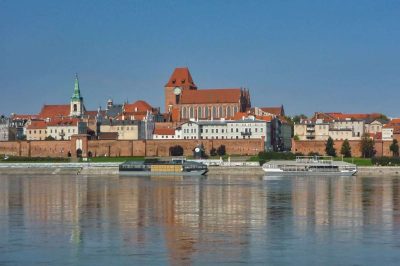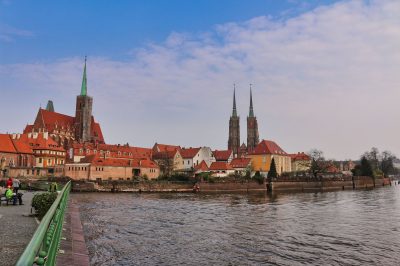Situated at the confluence of the Oppa (Opava) and Goldoppa (Opavice) rivers, Jägerndorf is considered one of the oldest towns in Bohemian Silesia. Largely neglected by German tourists, the city offers a wealth of sights that are worth at least a day trip.
History of Krnov (Jägerndorf)
Germans were settled here by the Bohemian King Wenceslas I as early as the 13th century and were granted town rights shortly afterwards. The Minorite Order chose Jägerndorf as the seat of a monastery in 1273, which was one of the most important in the region in the centuries to come. In 1529, the town also became the seat of the Duchy of Jägerndorf, which lasted until the 19th century and was first ruled by the Hohenzollern dynasty and later by the Liechtenstein dynasty.

Jägerndorf as a bone of contention between Prussia and Austria
In his conquest of Silesia, Frederick the Great of Prussia primarily invoked his rule over the Duchy of Jägerndorf when he started the First Silesian War. Ironically, however, Prussia was not awarded Jägerndorf in the subsequent Preliminary Peace of Breslau. Instead, it became a border town. In the 19th century, thanks to the construction of the Moravian-Silesian Central Railway and numerous Jewish textile manufacturers, Krnov developed into the textile center of Silesia and was also known as the “Silesian Manchester”. Many magnificent factory buildings and villas still bear witness to this today.
Czechoslovak years, German occupation and communism
Against the will of the majority German inhabitants, Jägerndorf became part of the newly founded Czechoslovakia in 1918 and became the administrative center of the region as Krnov. As a result of the Munich Agreement, German troops occupied the city in October 1938. Jews were persecuted and for the most part deported to concentration camps and murdered. When the Red Army occupied the town on May 6, 1945, Krnov was reincorporated into Czechoslovakia. The German inhabitants of the town were taken to internment camps in the following months and expelled to Germany. Instead, Moravians, Sinti and Roma moved to the city and, in the following years, Greeks who had fled the civil war in their country.
Things to see in Krnov
Krnov has a very compact but interesting old town. Even though the town was badly damaged during the Second World War and some streets were completely destroyed, it still has some very beautiful buildings.

Jägerndorf town hall and savings bank
The architect of the Austrian National Bank in Vienna, Leopold Bauer, a native of Jägerndorf, was supposed to have been the builder of the city’s new town hall. However, its draft was rejected by the councillors. Instead, they opted for the proposal by Viennese architect Moritz Hinträger, which was built between 1901 and 1903. The neo-Renaissance building is modeled on the Währing town hall in Vienna’s 18th district. The town hall was one of the few buildings on the market to survive the bombing of the town during the Second World War. Visitors can climb the 52-meter-high tower in the summer months. No less impressive is the adjacent Art Nouveau savings bank building. Built between 1906 and 1907 by the master builder Franz Blasch from Krnov, it also housed a café.
City Hall: Hlavní nám. 96/1, guided tours of the City Hall from May 15 to September 15 on Wednesdays at 10 am and 2 pm, Saturdays at 2 pm and Sundays at 9 am, cost 20Kč.
St. Martin’s parish church
First mentioned in 1281, the parish church of St. Martin is the most visible church in Krnov. A tower keeper has stood guard on the north tower since the Middle Ages. The church organ was built by the Rieger organ factory founded in Jägerndorf and served as a show organ for the factory. Since 2014, the tower has also been open to visitors and can be climbed.
St. Mary’s: Nám. Osvobození, guided tours on weekends from 13:00 to 18:00 or as a group on request at the tourist information office.
Church of the Holy Spirit
Founded in the 13th century together with a hospital, the church was later severely neglected. So much so that the Moravian Margrave Josta obliged the citizens of Krnov to restore the church. It has some of the oldest wall paintings in the region to thank for this. After frequent changes of ownership, the 27 murals were painted over and forgotten in the 16th century. They were only rediscovered in the 20th century and are now one of the city’s highlights.
Church of the Holy Spirit with hospital: Sv. Ducha 30, information on guided tours and visits at the city information office.
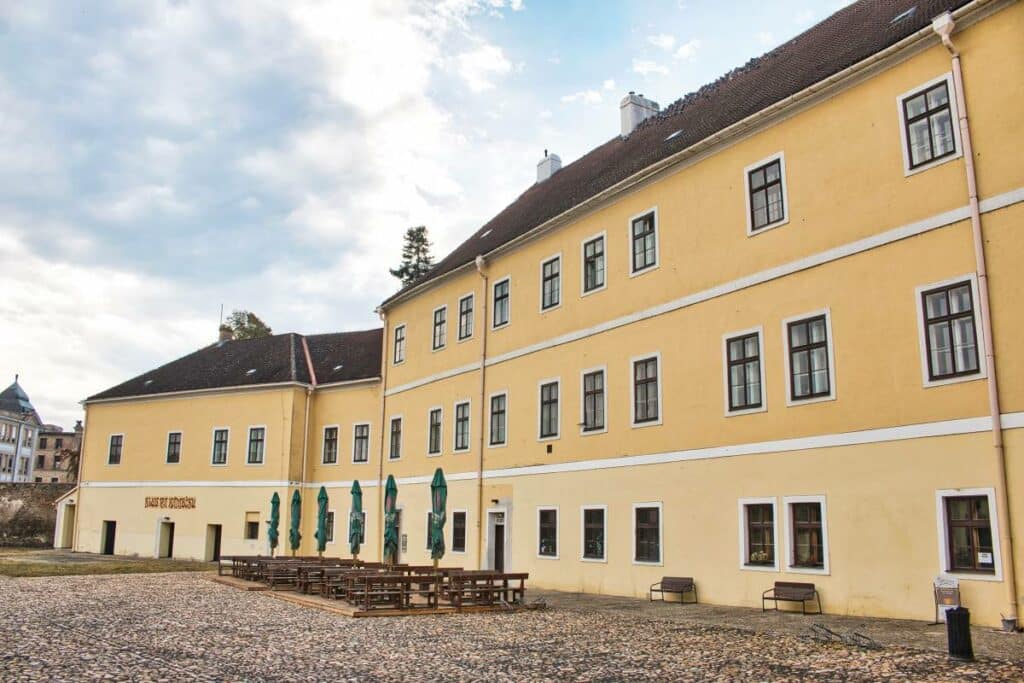
Jägerndorf Castle
The castle of the rulers of Jägerndorf had its heyday between the 16th and 17th centuries. After that, it increasingly fell into oblivion. Where once splendid parties were held, sometimes lasting a whole week, it is now quite quiet. A restaurant in the courtyard invites you to drink beer. There is not much else to see here.
Art Nouveau and modern architecture in Krnov
With the growing textile industry and the increasing prosperity of Krnov’s citizens, more and more prestigious buildings were built to reflect this wealth. In the first half of the 20th century in particular, many buildings were constructed in Krnov that are among the most beautiful modernist buildings in the Moravian-Silesian region.
Villa Flemmich
Textile manufacturer Theodor Flemmich wanted to have a villa built for himself and his family near the factory. He commissioned the Viennese artist Otto Prutscher, who designed the building according to Flemmich’s wishes. The interior has been lost, but the architecture is still impressive.
Villa Flemmich: Hlubčická ulice 20, open Tuesday to Sunday 8 am to 6 pm, admission 30Kč.
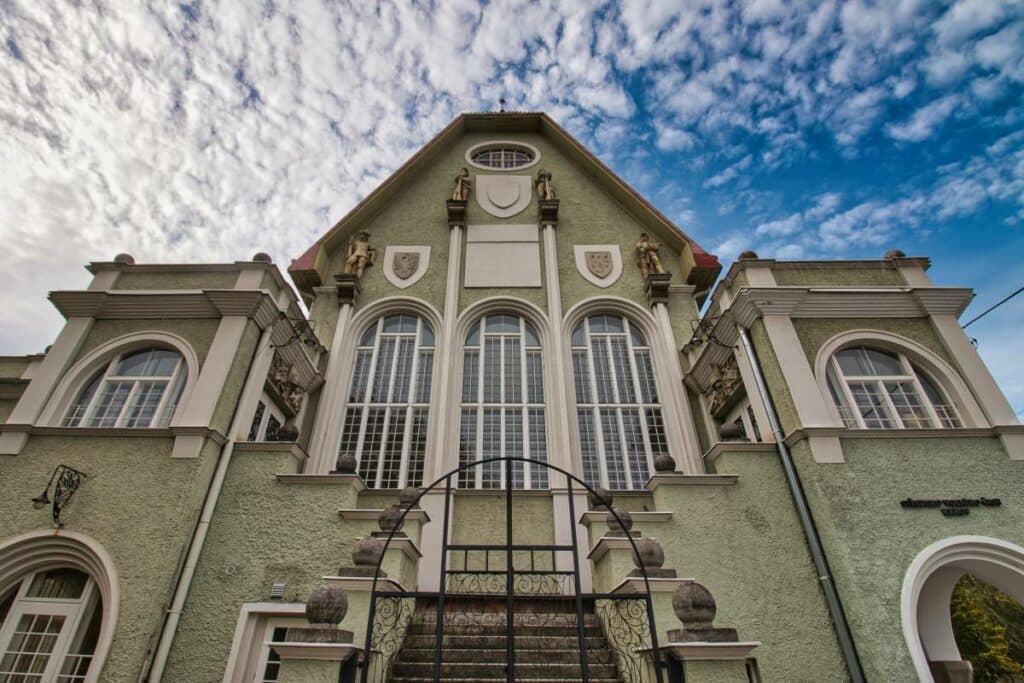
Schützenhaus
Below the castle hill is the Schützenhaus, which was one of Leopold Bauer’s first important designs. He planned it as an event center for the shooting club in 1904 and changed the idea again in 1907. The result is impressive and still attracts audiences to concerts in the building’s Art Nouveau hall today.
Schützenhaus: Dobrovského 16, open for events. Information on events at the city information office.
In addition to these buildings, there are other buildings worth seeing. Particularly photogenic are Villa Johann Chalpuček (Textilní ul. 3), Villa Karl Larisch (Říční okruh 6/12a), Villa Schnürch (Revoluční 893/46), the Silesia exhibition hall (Mikulášská ulice 1015/12), the theater (Mikulášská 911/21) and the polyclinic (Náměstí Hrdinů 6) and the Art Nouveau exterior, ČSSR cinema Mír 70 (nám. Míru 1).
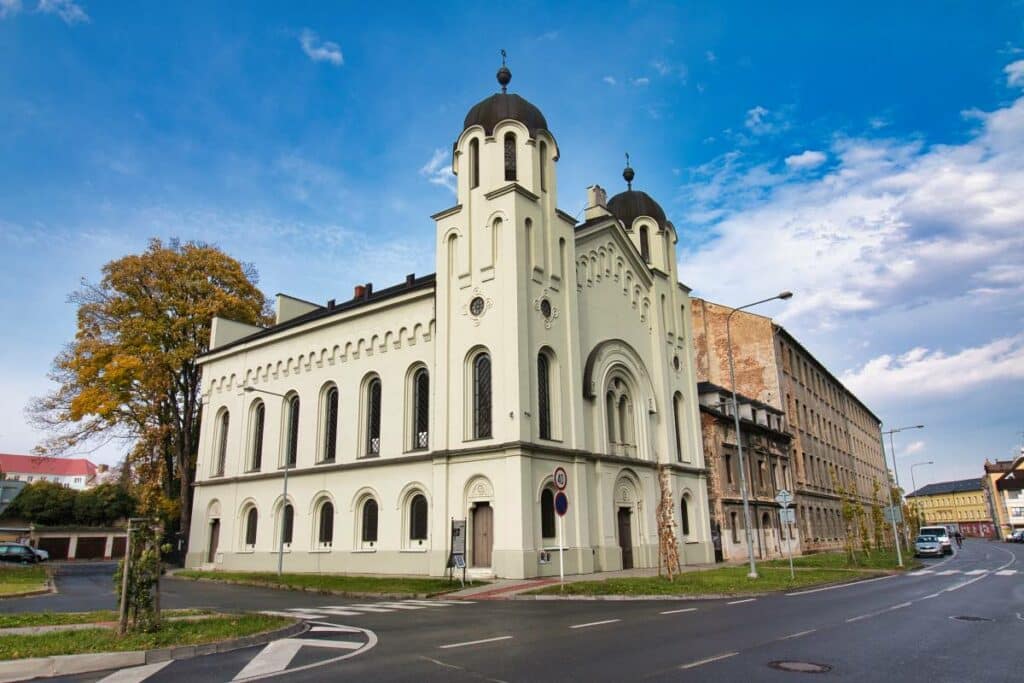
Jewish Krnov
Jews had been settling in the region since the 10th century and have been documented in Jägerndorf since the 13th century. However, in the 15th century, the envy of Christian merchants led to their banishment from the entire county. It was not until the middle of the 19th century that the number of Jews in Krnov increased again. In the 1860s, Jews were emancipated in Austria-Hungary. The first public Jewish community was established in Jägerndorf in the 1870s. Until the occupation of Czechoslovakia by Nazi Germany, they played a decisive role in Krnov and the region. Jews developed many industries and economic sectors in the town and region.
Krnov Synagogue
The synagogue in Krnov is unique for the region and is one of the best-preserved Jewish temples in the Czech Republic. It was built in 1871 according to plans by Ernst Latzel, a local building contractor. Even though the synagogue was not an orthodox temple, men and women could sit separately here too. Nevertheless, the Krnov synagogue has an organ, which is again typical of Reform Judaism. It was only one of three synagogues in Moravian Silesia to survive the Reichspogromnacht. Even the interior with its wooden coffered ceiling has been preserved to this day.

Today, the synagogue belongs to the Jewish community from Prague and is even occasionally used for prayers. The temple is also a venue for concerts and other events. An association of friends of the synagogue looks after the upkeep of the building and welcomes visitors.
Krnov Synagogue: Soukenická 83/28, www.krnovska-synagoga.cz, open from 10 am to 12 noon and from 1 pm to 3 pm, closed from October to April, admission 60Kč. If the door is locked, ring the bell.
Krnov Jewish Cemetery
The Jewish cemetery below the castle hill shows the interesting mix of the Jewish community. The Jewish cemetery in Krnov, established in 1874, was destroyed in 1939 after the occupation of the Sudetenland by Nazi Germany. Nevertheless, gravestones with German, Czech and Hebrew inscriptions can still be found here today.
Jewish cemetery Krnov: U Lazebníka 909/2
Castle Hill (Cvilín) in Krnov
No matter where you drive into Krnov from, the 441-metre-high Vordere Burgberg will probably be the first landmark of the town that you see. For the citizens of Jägerndorf, the Castle Hill has always been a favorite destination for walks. Several hiking trails criss-cross the area of the castle hill, which are also worth a walk to the castle that gave the hill its name. However, many believers also come here to experience spiritual cleansing.
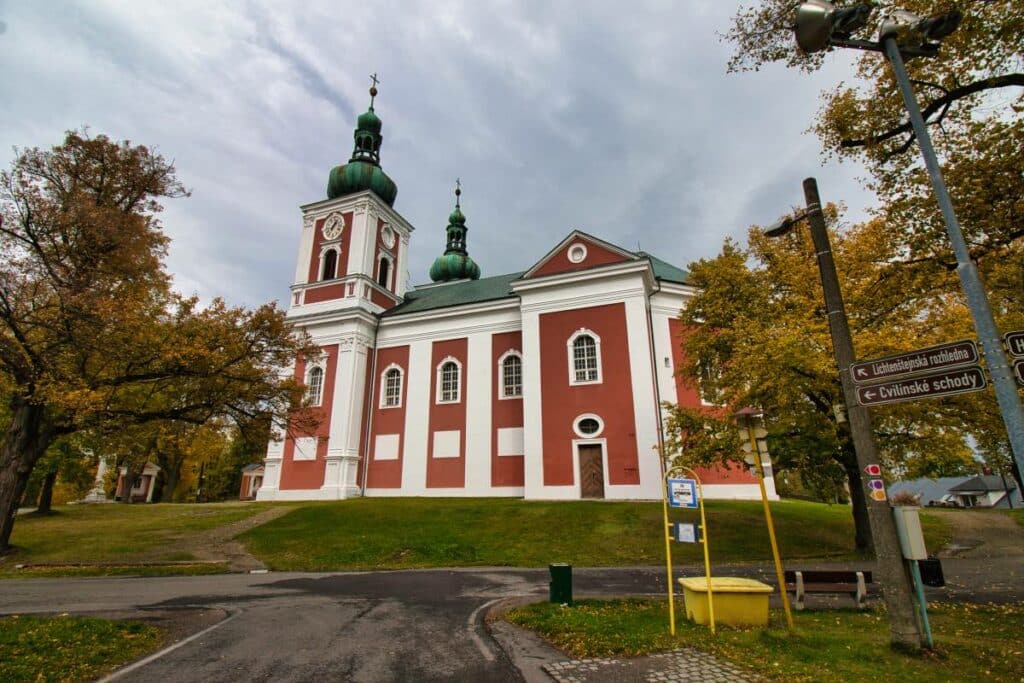
Pilgrimage church of the Blessed Virgin Mary
Created to re-Catholicize the region after the Thirty Years’ War, the pilgrimage church of the Sorrowful Virgin Mary primarily attracts believers to the Burgberg. There is an image of the Virgin Mary here, which the Krnov painter Heinrich Täuber painted and donated in 1683 as thanks for the healing of his daughter. Since then, pilgrims have come four times a year to ask for healing from illnesses. Because the small wooden chapel was bursting at the seams at the beginning of the 18th century, today’s pilgrimage church was built here from 1722 to 1728. To make the arduous journey from the town up the castle hill to the pilgrimage church easier, the people of Jägerndorf built a stone staircase with 222 steps in the 19th century. The church was badly destroyed at the end of the Second World War, but was later rebuilt in great detail thanks to many pictorial testimonies.
Liechtensteinwarte
At the beginning of the 20th century, the Moravian-Silesian Sudeten Mountains Association attempted to build a lookout in Jägerndorf. The project was supported by the Prince of Liechtenstein, which is where the name comes from. The Liechtenstein lookout tower built as a result, which was completed in 1903, offers a divine view over the entire region. The tower was once 35 meters high, but today it is still 29 meters high. Between the battlements on the platform, you can even see as far as the television tower on the Altvater in good weather.
Liechtensteinwarte: open from June to September from 10 am to 5 pm, from October to April at weekends and only in good weather. Outside of these times, ascents can be organized via the Krnov tourist information office.
Cvilín Castle
Around 1.5 kilometers from the pilgrimage church is the old Cvilín Castle, which has stood here on the Hintere Burgberg hill since at least 1253. Once the lofty residence of the Princes of Jägerndorf, the fortress lost its importance under the rule of the Prussian Hohenzollerns. Today, only some of the outer walls of the castle remain. But at least you can wander through the ruins and enjoy a view of the surrounding area from the former tower.
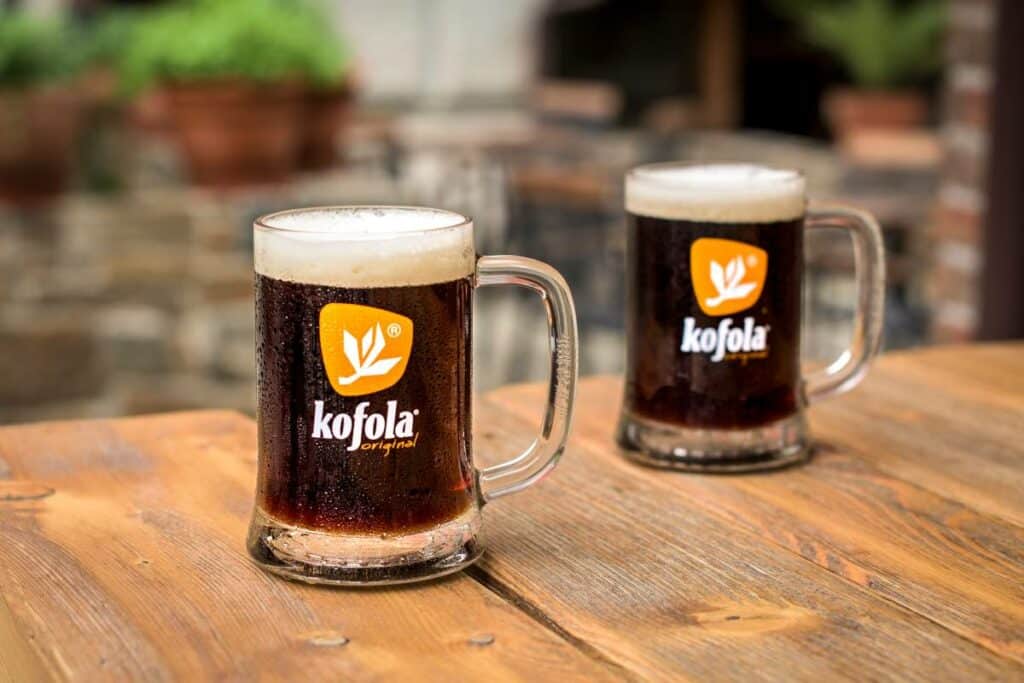
Krnov – the stronghold of Kofola
In the second half of the 19th century, a pharmacist named Gustav Hell in nearby Opava developed an extract from coffee beans. This was the basis for a syrup that a pharmaceutical company in Opava developed when it was looking for a use for the excess caffeine produced during coffee roasting. It came in handy that, in the absence of Western cola, the communist government of the ČSSR called on state-owned companies to develop their own drinks. This is how Kofola was finally created in 1960. Kofola became so immensely popular that it now competes with Coca Cola in the Czech Republic and Slovakia and is drunk more often than the American original. Today, the syrup is processed and bottled in Krnov at Kofola a.S.. Kofola takes some getting used to and initially tastes a bit like Jägermeister without the alcohol. You get used to it and it soon becomes addictive.
Kofola Music Club
Although the lemonade factory does not offer tours, it runs a club on the outskirts of Krnov where there are always concerts. Czech bands in particular play here, which is why a visit to the club can be worthwhile to get to know the local and national music culture better. Don’t worry, there’s also beer, of course.
Kofola Music Club: Bruntálská 1403, http://www.kofolamusicclub.cz
What to do in Krnov?
City tour
You can also book guided tours in German at the tourist information office (address below). Here you can learn interesting stories about the old hunting village. If you prefer to look around on your own but still want to know a little more, there is also an audio guide that you can borrow from the tourist information office.
Nachmelena Opice brewery tour
You can take part in a guided tour of the brewery “Angetüdelter Affe” in Krnov. The tour will be in English. Here you will be shown how the local craft beer is brewed and you can taste the beer there and then.
Nachmelena Opice Brewery: Textilní 1154/1 under the castle hill, www.nachmelenaopice.cz/
Events in Krnov
KRRR film festival for 70mm films
A special highlight in Krnov is the KRRR film festival. It is dedicated to 70mm films, which are popular among movie fans for their sharpness of detail and the surround sound that was still rare in the past. The Mír 70 cinema is one of the few cinemas in the Czech Republic that still has the technology to show these films. The festival is therefore a special highlight.
KRRR Festival: every year around the beginning of April in Krnov at the Mír 70 cinema (nám. Míru 1), https://www.krrr.cz/
Practical tips
Tourist information
The Krnov Tourist Information Office is located a few meters from the town hall at Hobzíkova 13. It provides information about the sights in the town and the surrounding area all year round and arranges accommodation. It is open from 9 am to 5 pm, except on Sundays.
Parking
Parking is possible in many places in the city. There is a charge directly on the marketplace. If you want to park your car without paying a fee, you can do so at Petrovická, for example.
Accommodation
Hotel Cvilín*
The Hotel Cvilín is located directly on the castle hill next to the pilgrimage church. From the building’s restaurant you have a great view over the city. The rooms are comfortably furnished. The hotel offers some luxury. But it is located on the castle hill and the 222 steps are certainly tiring on foot after 2.3 beers in the evening.
Villa Café*
Villa Café is closer to the center and, above all, not on the mountain. You can live comfortably and in style in this villa from the beginning of the 20th century. All rooms are modernly furnished. Many of them have great wooden parquet floors. The prices are cheaper than at the Hotel Cvilín. The breakfast is delicious.
Penzion Eva Krnov*
It is always cheap and easy to stay in guesthouses in the Czech Republic. In Krnov, the Penzion Eva Krnov is particularly recommended. The hosts are extremely friendly and help with whatever is needed.
Food & drink
Bistro Včera, dnes a zítra
The bistro Včera, dnes a zítra not only has a stylish ambience but also delicious dishes on the menu. The dishes are a welcome change, especially if you have already eaten a few Bohemian dishes in the meantime. The breakfast is also highly recommended. Usually only two dishes are available. However, the restaurant is only open from 7 a.m. to 3 p.m. during the week, but until 10 p.m. on Fridays.
Restaurant Hermes
Greeks who fled the civil war have been living in Krnov since the 1950s. It is therefore a good idea to eat Greek food in Krnov. Hermes is located in a listed building and there is probably no better place to enjoy a delicious lunch or dinner.
Male Café
The “little café” offers daily changing international dishes and, of course, coffee in a friendly atmosphere.
Shopping
Pekárna Zdravá výživa
The “Healthy Food” bakery on the corner of Radniční and Zámecké nám. offers fresh baked goods as well as many regional products from all over the region. If you have some space in your luggage or even more in your car, you should stock up on delicious Czech food here.


